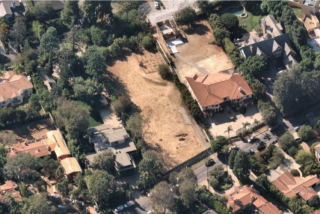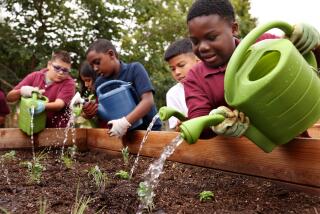Opinion: Green space and gray matter: Why L.A’s. kids are short on both
- Share via
Meet Britani, a young teen, busy on her smartphone, sitting in her freeway-adjacent bedroom with her windows closed. It’s a beautiful, warm day, but Britani is stuck inside, a casualty of her neighborhood’s treeless streets, dead lawns and polluted air.
Like tens of thousands of children in Los Angeles, Britani’s neighborhood suffers from terminal park poorness. Nearly half — 41% — of lower-income households in Los Angeles do not have immediate access to a park. Many, like Britani, live next to the freeway, which makes it even more difficult for them to go outside and get fresh air.
Britani’s mom reads the news — which means she’s seen the countless stories about how growing up near a freeway makes Britani much more likely to develop asthma from inhaling noxious car pollution and particulates. She can’t afford to move to a greener neighborhood, so she and Britani stay inside as much as possible.
To keep Britani’s lungs healthy, this seems a wise strategy. But it isn’t without consequence. Though her mom doesn’t realize it, without access to adequate green space, Britani’s brain development suffers. In fact, the damage to Britani’s brain started before she was even born.
The culprit was stress.
Any perceived threat, big or small, evokes a stress response in humans. Threats related to a lack of green space (e.g. overexposure to the sun) are micro-stressors, posing minimal risk compared with violent or catastrophic events. That said, most green-space micro-stressors are continuous. Ongoing stress caused by insufficient access to the outdoors, even if mild, creates cumulative damage by over-using the “fight or flight” stress response. When this happens, the physical mechanisms designed to protect us instead begin to harm us. Surges in blood pressure that move oxygen to the limbs — great in a fight — suddenly lead to hypertension.
When Britani was conceived, the biological histories of her parents converged in her DNA. Epigenetic mechanisms passed on her parents’ current life experiences and learned behavior. If you think of genes as light switches with dimmers, epigenetic mechanisms would be the hand that decides which lights are on, off, dim or bright.
About 16 days after conception, Britani’s brain begins to develop. Imagine Britani’s mom — young, pregnant for the first time, money in the household is tight — and she’s cooped up in a small apartment with her new, overworked husband. And there’s no place to get outside and unwind.
The smart money is on her experiencing some stress.
This stress causes Britani’s mom to create excess hormones (glucocorticoid), which she transfers to unborn Britani because they are physically connected. This hormone alters Britani’s fetal brain and its stress response system in ways that can affect her cardiovascular, immune and metabolic functions, as well as predispose her to emotional and psychiatric vulnerabilities once she’s born.
Never having taken a breath, Britani is already at a disadvantage compared with kids from greener neighborhoods. Sadly, the damage doesn’t end there. As Britani is born and grows older, the deficit of green space in her life has an even more direct effect.
For young children, observing plant life promotes intellectual curiosity and helps develop the thinking part of their brain. New studies show increased green space improves working memory in children.
Once again, Britani is losing out.
As she grows older, there are social consequences to Britani’s indoor isolation. Green space encourages social bonding that often begins with a simple hello in passing during a walk. Humans are a social species. We feel safer when we connect with our neighbors. This generates positive cues that promote healthier brain development for young Britani. The safer her brain feels, the better it will develop.
Neural networks in the brain resemble trees — if the twig is bent, so grows the branch. With all the issues surrounding the state of Los Angeles’ schools, parks and green space may seem like secondary concerns. But the reality is that children — and their brains — have a biological need for green space.
A healthy outdoor environment is food for the young brain. And, right now, too many of L.A.’s kids are malnourished.
Billi Gordon is a neuroscientist at the Ingestive Behaviors and Obesity Program at the Oppenheimer Center for the Neurobiology of Stress at UCLA. Follow him on Twitter @drbillyg.
Follow the Opinion section on Twitter @latimesopinion and Facebook
More to Read
A cure for the common opinion
Get thought-provoking perspectives with our weekly newsletter.
You may occasionally receive promotional content from the Los Angeles Times.










